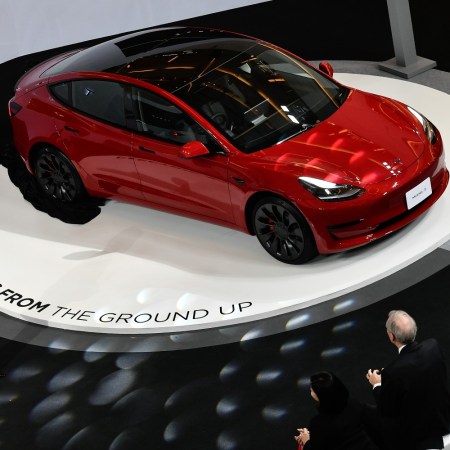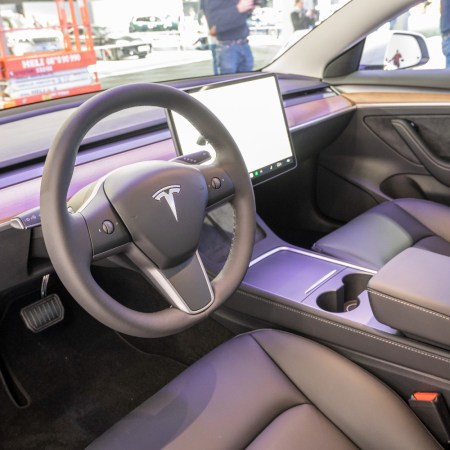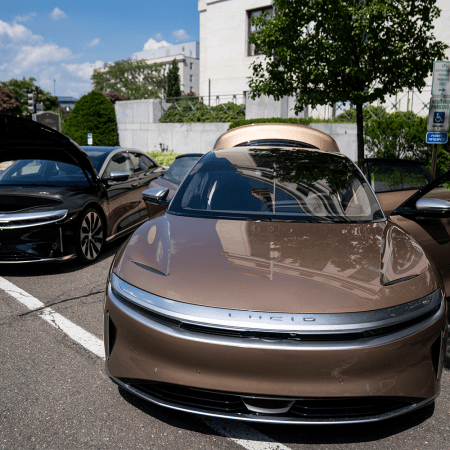I fall in love with a new concept car every other day. Which is a problem. Because without fail, they break my heart.
There was the Cadillac Escala, a beautiful tease that will presumably never go into production. The Jaguar I-Pace, which, despite going electric, dropped the fanciful futuristic gadgetry that made it so enticing to begin with.
I was beginning to think I would never love again. But then I walked into Classic Car Club on the West Side of Manhattan and set my eyes on it: the Lucid Air, a vehicle that at first sight can make a grown woman say, “I’m gonna marry that girl someday.”
Because what you see is what you get. While most companies blow billions on concept models only to put them in production as a shadow of the original, Lucid Motors promises otherwise. Which is to say: very little will (allegedly) change come the official production release in 2019.
It’s all noise until then, and the Silicon Valley-based automaker is set to give Tesla some serious competition, in part due to CTO Peter Rawlinson, a former Tesla Vice President of Vehicle Engineering, who was on hand to show off the Lucid’s features.
“Does Tesla mind that you design for Lucid now?” I asked him from the driver’s seat as I took it around the block. “Have they blocked you on Instagram? Unfriended you on Facebook?”
“No, certainly not,” he said. “Elon Musk has said that they welcome competition. And I think that he’d be pleased that we’ve created some.”
Like the Tesla Model 3, the Air has no traditional grille. Aesthetically, it’s not a look for everyone, but I reckon it looks downright intimidating. But the real dog-and-pony show happens inside.
Sitting in the fine leather-upholstered back seat, Rawlinson hits the touchscreen on the middle console. The seats have three different settings: upright, slightly reclined and full-on nap mode. Mind you, I’m nearly six feet tall. But the seat laid me out like a board with ease.
The concentration on the back-seat experience is in preparation for the future: by 2019, the rider experience might be very different than it is now. It could replace the Uber Black Car and offer a superior experience for the business class. And while you might be thinking that Uber isn’t going to be using luxury cars for such a thing, I can tell you I’ve rideshared in everything from an Audi to a Mercedes to a Bugatti (even if it was a PR stunt). So with a starting price of $60k before taxes, the Air seems a viable option to this humble editor.
But Lucid is also creating the heightened back-seat experience with the Chinese market in mind. While most manufacturers make specialized “long” cars for China to compensate for their fervent rideshare market, the Air’s length is standard. (Luxury for everyone!). You can thank the Air’s electric-vehicle hardware for the grandiose interior: less engine components means more room for you. Makes for easier compact parking as well.
And as if that wasn’t all enough, the Lucid Air will have the capacity — but not the ability, at least yet — to accomodate autonomous driving. The self-driving hardware will be in place, but the software to kick her into action will come later, presumably when self-driving vehicles are, you know, legal. Another reason why so much attention was paid to the back-seat experience.
The front seat also delivers some ultra-luxe gadgetry. The driver faces three artfully designed, fully customizable screens above the wheel. The look of the projections is graceful — not alien-like — and you can see everything at once. There’s no scrolling through a million screens to get the information you need. Safe and convenient, as it should be. In the center, a retractable iPad touch screen hides a secret compartment for locking away valuables. And from the screen, one can easily access all the regular players: Apple CarPlay, Nest, August Smart Lock, etc.
“So tell me true, Peter, can someone hack it?” I asked.
“We hired a person who is extremely adept at both building and breaking code for that,” he said.
“You hired a hacker. Good on you.”
“So … famous last words, the Air will be unhackable,” he said, and we both crossed our fingers crossed.
But the real kicker, for this editor, at least, is the Air’s panoramic sunroof. The windshield extends the entire length of the roof, allowing for maximum star-gazing like never before. To avoid too much sun during the day and allow for privacy, the Air will use electrochromic glass (much like the Boeing 787 Dreamliner) that can adjust the amount of light that enters. There’s also a solid roof option for those who prefer to be enclosed. Which would be nothing short of a travesty, but hey, it’s your $60 grand.
Now I know what you’re wondering: This is all fine and well, but how’s it drive?
What I can tell you from my (super-brief) ride is that the Air lives up to its name. It feels like a sentient piece of silk, gliding down the road with narry a bump or jostle. Except silk doesn’t come with 1,000 horsepower … and this does. The expected 0-60 time is 2.5 seconds, with a top speed of about 160 and a proposed 200 down the line. Plus, this battery will have the capability to take you 400 miles on a single charge. So the next time a big manufacturer tells you their new EV can go 200 miles on a charge, tell ’em they can do better.
All in all, the Lucid Air is the car we want to drive off into the Apocalypse — or at least be sitting in, as it drives itself there.
This article was featured in the InsideHook newsletter. Sign up now.





















